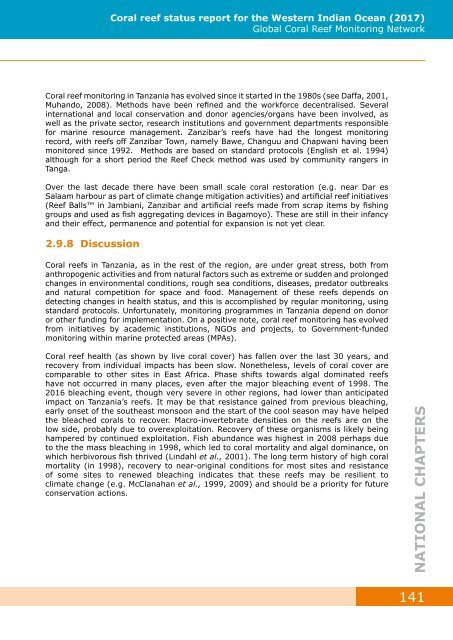GCRMN_COI_2017-Western Indian Ocean Reef Status
GCRMN Western Indian Ocean Coral Reef Status report for 2017. Produced by the Indian Ocean Commission and CORDIO East Africa
GCRMN Western Indian Ocean Coral Reef Status report for 2017. Produced by the Indian Ocean Commission and CORDIO East Africa
Create successful ePaper yourself
Turn your PDF publications into a flip-book with our unique Google optimized e-Paper software.
Coral reef status report for the <strong>Western</strong> <strong>Indian</strong> <strong>Ocean</strong> (<strong>2017</strong>)<br />
Global Coral <strong>Reef</strong> Monitoring Network<br />
Coral reef monitoring in Tanzania has evolved since it started in the 1980s (see Daffa, 2001,<br />
Muhando, 2008). Methods have been refined and the workforce decentralised. Several<br />
international and local conservation and donor agencies/organs have been involved, as<br />
well as the private sector, research institutions and government departments responsible<br />
for marine resource management. Zanzibar’s reefs have had the longest monitoring<br />
record, with reefs off Zanzibar Town, namely Bawe, Changuu and Chapwani having been<br />
monitored since 1992. Methods are based on standard protocols (English et al. 1994)<br />
although for a short period the <strong>Reef</strong> Check method was used by community rangers in<br />
Tanga.<br />
Over the last decade there have been small scale coral restoration (e.g. near Dar es<br />
Salaam harbour as part of climate change mitigation activities) and artificial reef initiatives<br />
(<strong>Reef</strong> Balls in Jambiani, Zanzibar and artificial reefs made from scrap items by fishing<br />
groups and used as fish aggregating devices in Bagamoyo). These are still in their infancy<br />
and their effect, permanence and potential for expansion is not yet clear.<br />
2.9.8 Discussion<br />
Coral reefs in Tanzania, as in the rest of the region, are under great stress, both from<br />
anthropogenic activities and from natural factors such as extreme or sudden and prolonged<br />
changes in environmental conditions, rough sea conditions, diseases, predator outbreaks<br />
and natural competition for space and food. Management of these reefs depends on<br />
detecting changes in health status, and this is accomplished by regular monitoring, using<br />
standard protocols. Unfortunately, monitoring programmes in Tanzania depend on donor<br />
or other funding for implementation. On a positive note, coral reef monitoring has evolved<br />
from initiatives by academic institutions, NGOs and projects, to Government-funded<br />
monitoring within marine protected areas (MPAs).<br />
Coral reef health (as shown by live coral cover) has fallen over the last 30 years, and<br />
recovery from individual impacts has been slow. Nonetheless, levels of coral cover are<br />
comparable to other sites in East Africa. Phase shifts towards algal dominated reefs<br />
have not occurred in many places, even after the major bleaching event of 1998. The<br />
2016 bleaching event, though very severe in other regions, had lower than anticipated<br />
impact on Tanzania’s reefs. It may be that resistance gained from previous bleaching,<br />
early onset of the southeast monsoon and the start of the cool season may have helped<br />
the bleached corals to recover. Macro-invertebrate densities on the reefs are on the<br />
low side, probably due to overexploitation. Recovery of these organisms is likely being<br />
hampered by continued exploitation. Fish abundance was highest in 2008 perhaps due<br />
to the the mass bleaching in 1998, which led to coral mortality and algal dominance, on<br />
which herbivorous fish thrived (Lindahl et al., 2001). The long term history of high coral<br />
mortality (in 1998), recovery to near-original conditions for most sites and resistance<br />
of some sites to renewed bleaching indicates that these reefs may be resilient to<br />
climate change (e.g. McClanahan et al., 1999, 2009) and should be a priority for future<br />
conservation actions.<br />
NATIONAL CHAPTERS<br />
141


















